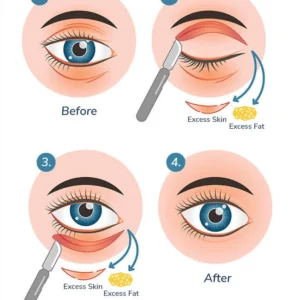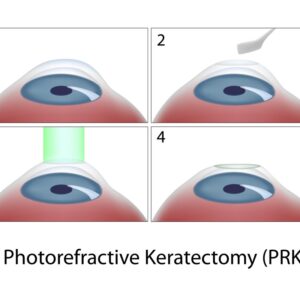Description
✨ Extracapsular Cataract Extraction (ECCE): Reliable, Global Solution for Advanced Cataracts 🌍
Executive Summary 📋
Extracapsular Cataract Extraction (ECCE) is a trusted surgical approach for treating dense or mature cataracts. This method excels where newer laser techniques may be challenging. Consequently, it remains a vital, reliable option worldwide, ensuring excellent outcomes by preserving the necessary lens structure for secure Intraocular Lens (IOL) placement. Therefore, it is a cornerstone of global Cataract Surgery.
Understanding Extracapsular Cataract Extraction (ECCE) 🔎
The **Extracapsular Cataract Extraction (ECCE)** technique involves removing the hardened inner lens nucleus through a slightly larger incision (8–10mm). The surgeon then carefully suctions out the remaining soft outer cortex. Importantly, this process intentionally leaves the posterior capsule intact, a crucial step for the stability of your new lens. If you want to learn more about the term: What is ECCE?
The Importance of the Posterior Capsule 🛡️
Leaving the posterior capsule untouched provides crucial structural support. It acts as a natural hammock, which is necessary to securely hold the IOL in the correct anatomical position. Furthermore, this leads to better visual quality and reduces complications associated with lens instability.
Who is This For? 🎯
Although micro-incision surgery is common, your specialist may recommend **Extracapsular Cataract Extraction (ECCE)** in several specific situations. These scenarios prioritize safety over speed when facing complex conditions. Accordingly, patients should trust their surgeon’s expertise when this recommendation is made.
- 👉 **Very Dense Cataracts:** When the lens is too hard (mature) for the ultrasound energy used in Phacoemulsification.
- 👉 **Zonular Weakness:** If the lens-supporting fibers are weak, ECCE allows for controlled manual removal, reducing the risk of lens dislocation.
- 👉 **Accessibility:** It is often the preferred, safest choice in high-volume global centers where specialized Phaco equipment is not readily available or cost-effective.
ECCE Advantages and Considerations ⚖️
Patients should carefully evaluate the unique benefits and drawbacks of **Extracapsular Cataract Extraction (ECCE)**. Generally speaking, ECCE offers a high level of surgical reliability, which is critical in challenging or advanced cases. Furthermore, it provides broader accessibility across global medical tourism destinations.
| Feature | Pros ✅ (The Upside) | Cons ❌ (Considerations) |
|---|---|---|
| Dense Cataracts | Highly effective for rock-hard cataracts, preventing corneal damage associated with Phaco. | Requires a larger surgical incision (8–10mm) compared to 2–3mm for Phaco. |
| IOL Stability | Posterior capsule preservation ensures optimal IOL stability and long-term positioning. | Higher risk of surgically induced astigmatism, which may require corrective glasses later. |
| Accessibility & Cost | Lower equipment costs make the procedure widely accessible and more affordable globally. | Slower visual recovery time due to the necessary corneal sutures and larger incision size. |
Comparison: ECCE vs. Modern Techniques 📊
The **Extracapsular Cataract Extraction (ECCE)** technique holds a safe middle ground between older and newer methods. Because of this versatility, it is frequently chosen in medical tourism destinations like Iran or Turkey as part of a competitive global medical tourism package.
| Procedure | Incision Type | Suture Need | Primary Use Case |
|---|---|---|---|
| ICCE | Large, Non-Capsular | Always | Historically (Rarely today) |
| ECCE | Medium (8–10mm) | Usually | **Dense Cataracts** |
| Phaco (MICS) | Micro (2–3mm) | No (Self-Sealing) | Standard/Soft Cataracts |
Patient Journey: Mr. Al-Sayed’s Successful ECCE 🗺️
Mr. Al-Sayed, a 70-year-old, traveled abroad seeking surgery for his severely dense cataracts. Due to the hardness of the lens, his surgeon recommended **Extracapsular Cataract Extraction (ECCE)** to avoid corneal damage. Therefore, the lens nucleus was safely removed in one piece, completely avoiding undue stress on the eye’s internal structures.
Since the posterior capsule was perfectly preserved, a high-quality IOL was placed securely. After a structured 10-day post-op stay and rigorous follow-up, his vision improved dramatically. When planning surgery abroad, always review the clinic’s protocols using our Surgeon and Clinic Checklist, and use a pre-travel preparation guide like the Pre-Travel Checklist. Additionally, secure travel permits using our Medical Visa Handbook.
Frequently Asked Questions (FAQ) 💬
1. Is Extracapsular Cataract Extraction (ECCE) considered outdated compared to Phacoemulsification?
No, ECCE is not outdated. While Phacoemulsification is the most common technique today, ECCE remains the standard of care for specific, difficult cases, such as extremely dense cataracts or when the natural lens support (zonules) is weak. It is a reliable, manually controlled procedure.
2. Why is preserving the posterior capsule so important during ECCE?
Preserving the posterior capsule is essential because it provides a necessary, stable hammock-like structure. This structure is required to securely hold the permanent Intraocular Lens (IOL) implant in its correct anatomical position, which ensures clear, long-term vision.
3. How long will I typically need to stay in the country after my ECCE surgery?
Due to the larger incision in ECCE, initial healing is slower than in micro-incision surgery. Therefore, we generally recommend patients remain in the country for 7 to 10 days. This allows for critical post-operative checks and suture removal by the surgeon.
4. Will the larger incision used in ECCE leave a noticeable scar?
The ECCE incision is typically made in the sclera (the white part of the eye) or near the junction of the cornea and sclera. While sutures are usually required, the incision heals well and is generally not noticeable to the casual observer once the eye fully recovers.
5. What type of vision correction can I expect immediately after the ECCE procedure?
Vision will be blurry immediately following surgery and will gradually improve. Because ECCE requires sutures, temporary astigmatism is common. The final visual prescription is determined after the sutures are removed and the eye has stabilized, usually a few weeks later.
6. What activities must I strictly avoid during the first month of recovery?
You must avoid any activity that increases pressure on the eye. This includes heavy lifting, strenuous exercise, vigorous coughing or sneezing, and bending over from the waist. Additionally, avoid getting water or soap directly in the eye.
7. Can I have both eyes treated for cataract using ECCE at the same time?
Generally, no. Surgeons usually perform cataract surgery one eye at a time, especially with ECCE due to the moderate recovery period. This allows the first eye to begin healing before the second procedure is scheduled, prioritizing patient safety.
8. What is the key difference between ECCE and Manual Small Incision Cataract Surgery (MSICS)?
MSICS is a modern variation of ECCE. It uses a smaller, self-sealing scleral tunnel incision that typically minimizes the need for sutures. In contrast, standard ECCE requires a longer incision and sutures, leading to a slightly longer visual recovery.
9. Will I need to stop taking my blood thinners (like aspirin) before the ECCE surgery?
This is a critical pre-operative instruction. You must discuss all medications, especially blood thinners, with your surgeon well in advance. Sometimes, these must be temporarily stopped or adjusted to reduce the risk of bleeding during the procedure.
10. How is the Intraocular Lens (IOL) power calculated for ECCE?
IOL power is calculated using specialized measurements called biometry, performed during the pre-operative consultation. This advanced measurement calculates the exact lens power needed to optimize your distance vision after the cloudy natural lens is removed.
11. What if I experience sudden pain or vision loss after returning home from the ECCE surgery?
Sudden, severe pain or a rapid drop in vision is a medical emergency. You must immediately contact your local ophthalmologist and notify your WMedTour coordinator. Immediate medical attention is essential to prevent permanent damage.
12. How does the recovery cost of ECCE abroad compare to Phacoemulsification?
While the ECCE procedure itself is often less expensive due to lower equipment costs, the recovery period is slightly longer. Therefore, you must budget for a few extra days of accommodation and associated expenses compared to the faster recovery seen with Phacoemulsification.






Reviews
There are no reviews yet.